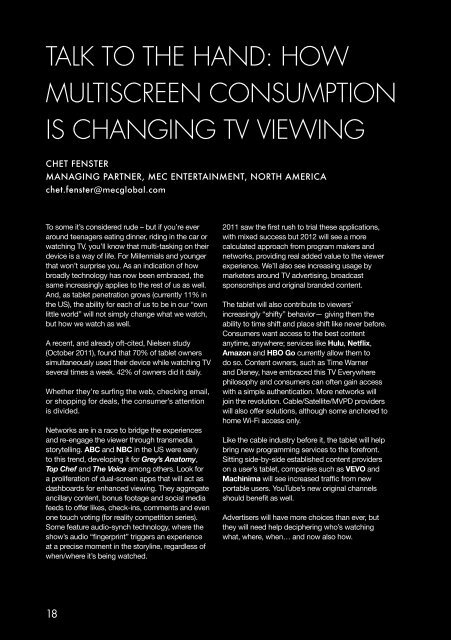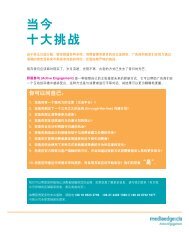IntroductIon - MEC
IntroductIon - MEC
IntroductIon - MEC
You also want an ePaper? Increase the reach of your titles
YUMPU automatically turns print PDFs into web optimized ePapers that Google loves.
tAlk to the hAnd: how<br />
multIscreen consumptIon<br />
Is chAngIng tV VIewIng<br />
cHet fenSter<br />
ManaGinG Partner, Mec entertainMent, nortH aMerica<br />
chet.fenster@mecglobal.com<br />
To some it’s considered rude – but if you’re ever<br />
around teenagers eating dinner, riding in the car or<br />
watching TV, you’ll know that multi-tasking on their<br />
device is a way of life. For Millennials and younger<br />
that won’t surprise you. As an indication of how<br />
broadly technology has now been embraced, the<br />
same increasingly applies to the rest of us as well.<br />
And, as tablet penetration grows (currently 11% in<br />
the US), the ability for each of us to be in our “own<br />
little world” will not simply change what we watch,<br />
but how we watch as well.<br />
A recent, and already oft-cited, Nielsen study<br />
(October 2011), found that 70% of tablet owners<br />
simultaneously used their device while watching TV<br />
several times a week. 42% of owners did it daily.<br />
Whether they’re surfing the web, checking email,<br />
or shopping for deals, the consumer’s attention<br />
is divided.<br />
Networks are in a race to bridge the experiences<br />
and re-engage the viewer through transmedia<br />
storytelling. ABC and NBC in the US were early<br />
to this trend, developing it for Grey’s Anatomy,<br />
Top Chef and The Voice among others. Look for<br />
a proliferation of dual-screen apps that will act as<br />
dashboards for enhanced viewing. They aggregate<br />
ancillary content, bonus footage and social media<br />
feeds to offer likes, check-ins, comments and even<br />
one touch voting (for reality competition series).<br />
Some feature audio-synch technology, where the<br />
show’s audio “fingerprint” triggers an experience<br />
at a precise moment in the storyline, regardless of<br />
when/where it’s being watched.<br />
2011 saw the first rush to trial these applications,<br />
with mixed success but 2012 will see a more<br />
calculated approach from program makers and<br />
networks, providing real added value to the viewer<br />
experience. We’ll also see increasing usage by<br />
marketers around TV advertising, broadcast<br />
sponsorships and original branded content.<br />
The tablet will also contribute to viewers’<br />
increasingly “shifty” behavior— giving them the<br />
ability to time shift and place shift like never before.<br />
Consumers want access to the best content<br />
anytime, anywhere; services like Hulu, Netflix,<br />
Amazon and HBO Go currently allow them to<br />
do so. Content owners, such as Time Warner<br />
and Disney, have embraced this TV Everywhere<br />
philosophy and consumers can often gain access<br />
with a simple authentication. More networks will<br />
join the revolution. Cable/Satellite/MVPD providers<br />
will also offer solutions, although some anchored to<br />
home Wi-Fi access only.<br />
Like the cable industry before it, the tablet will help<br />
bring new programming services to the forefront.<br />
Sitting side-by-side established content providers<br />
on a user’s tablet, companies such as VEVO and<br />
Machinima will see increased traffic from new<br />
portable users. YouTube’s new original channels<br />
should benefit as well.<br />
Advertisers will have more choices than ever, but<br />
they will need help deciphering who’s watching<br />
what, where, when… and now also how.<br />
18 19




